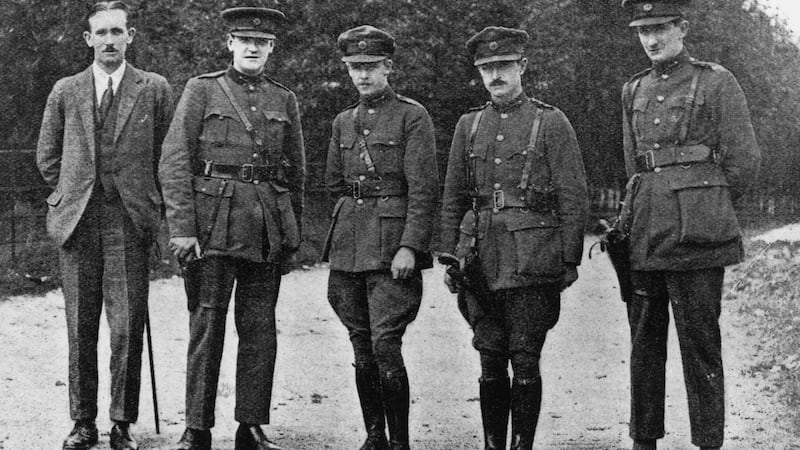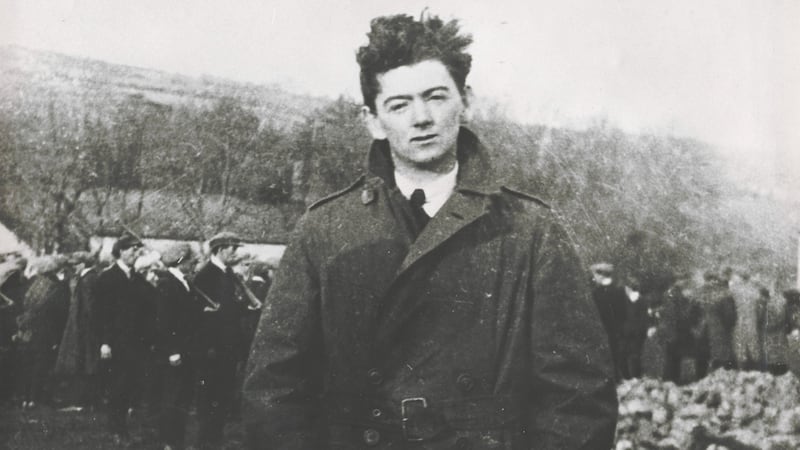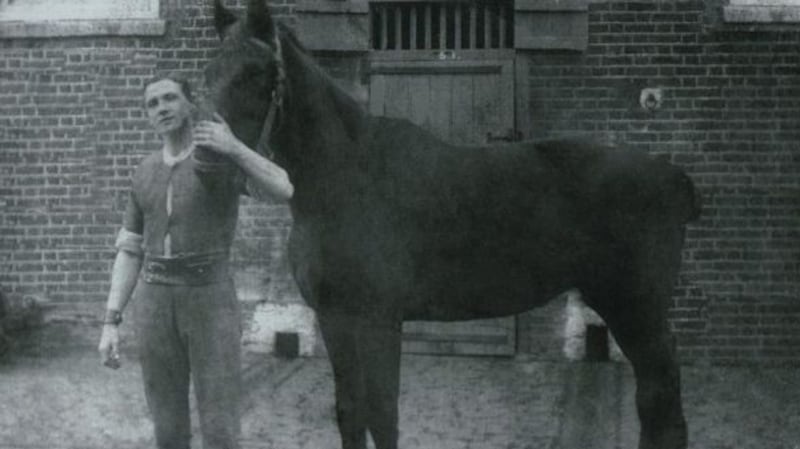January 21st, 1919 was an auspicious day in Irish history. The War of Independence started when men from the 3rd Tipperary Brigade of the Irish Volunteers shot dead two Royal Irish Constabulary (RIC) officers at Soloheadbeg outside Tipperary Town. In Dublin, the first Dáil was convened at three in the afternoon at the Mansion House.
The late start had been designed to facilitate 400 former Royal Dublin Fusilier prisoners-of-war who attended a banquet in the Round Room. These men had been mostly incarcerated in Limburg, the camp in Germany where Sir Roger Casement and Proclamation signatory Joseph Mary Plunkett had – largely unsuccessfully – pleaded with them in 1915 to turn tail on the British army and fight instead with the Germans.
Among those present in the Mansion House was the Kilkenny priest Fr Thomas Crotty, who did more than any one to ensure Casement's bag was a small one. He told the men in Limburg they had taken an oath under God to the King. Just 56 Irishmen out of 2,200 incarcerated in Limburg joined the Casement Brigade.
The Irish Times reported the Mansion House gathering was a joyous occasion. "Men who had experienced all the horrors of war and the brutalities of captivity chatted and jested like schoolboys and made light of their trials."
As the men left the building to attend a theatre engagement they were met on their way in by Sinn Féin supporters. These groups of loyalists and republicans would frequently clash over the coming years, but not on this day. "The contrast in the composition of the two crowds was so sharp that the situation became humorous rather than serious," The Irish Times reported.

The incident represented literally and metaphorically one Ireland departing and another one arriving. What must it have been like for so many Irishmen to come home from the war to be told that they had wasted their time in the service of an army that was now an enemy of the Irish people?
Life for ex-servicemen was hard everywhere. All had endured horrors which were unthinkable when cheering crowds saw them off during those prelapsarian days of August 1914.
Ex-British servicemen and their dependants constituted a half a million people in a State of just 3.3 million
For the Irish who returned home, their fate was compounded by the political situation. These men were shunned, ostracised from Irish society and in many cases murdered by the IRA, but that is only part of the story.
Some 210,000 Irishmen served in the British Army in the first World War. There were simply too many for them to be ignored. Together, with their families, they constituted a broad swathe of Irish society. In garrison towns such as Tralee, Nenagh and Maryborough (Portlaoise), ex-British servicemen made up 20 per cent of the population.
In a debate in the Dáil in 1924, William Redmond, the son of the Irish Party leader John Redmond, said ex-British servicemen – he was one himself – and their dependents constituted a half a million people in a State of just 3.3 million.
Ambivalent
The Free State Government may in some ways have been thankful for their presence, given the preponderance of first World War veterans (perhaps up to 50 per cent) who served in the National Army during the Civil War, but its attitude was ambivalent at best.
That government also offered to support a memorial to the Irish who died, but not in Merrion Square as had been proposed by a committee set up for that purpose. A memorial so close to Government Buildings would give the impression to the passing stranger that the origins of the State were “connected with those lives lost in the Great War”, the then minister for justice Kevin O’Higgins told the Dáil.
“This State has other origins,” he added bluntly in what would become the mantra of official Ireland for decades afterwards.

According to the historian Michael Robinson, an avid student of British armed services pension records in Ireland, 135,000 British ex-servicemen were living in what is now the Republic of Ireland in 1921. Of these, 37,500 had a disability of one sort or another.
Some first World War veterans were able to return to their old jobs, but many faced poverty.
The Ministry for Labour in London reported that the Irishman who returned from the front found "their own people have nothing but contempt to offer him for patriotism and sacrifice, and he is denied the right to work or live in the country [for] which he fought".
What is remarkable is that few, even those who would go on to become republicans, ever expressed regret about participating in the war.
‘Godforsaken country’
"My father was absolutely proud of his service," says Bill Powderly of his father William. "He went to the memorial service at Islandbridge every year. We all did. We were fortunate because we were Church of Ireland. It was in our tradition.
"There is a narrative that the only reason the Irish joined up was for the money. My father joined because he felt it was the right thing to do. I would say that many of the dead in Flanders Fields would be insulted if you said they fought for the money."
William Powderly drove ambulances in the Royal Army Service Corps. After the war he drove a bus for the Great Northern Railway company. He was late to fatherhood. Bill was born when his father was in his 50s. William died at the age of 65 in 1957.
He was attacked by two men on the streets of Mohill one day, but any man who came through the Boer War and the first World War was well able to take care of himself
“My father died when I was 10,” says Bill. “We never had an adult conversation about the war, but I remember him talking about a town called ‘Wipers’ [Ypres], and I also remember as a child he didn’t allow us to have cowboy guns because he knew what guns could do. When he eventually allowed us to have pop guns, he spent the time showing us how to drill with the gun rather than shoot it.”
Peter Gordon’s father Thomas joined the British army in 1896 and went on to fight in the second Boer War. His family bought him out of the army and he trained as a vet. He joined the Royal Army Veterinary Corps during the first World War and was mentioned in dispatches for his bravery.
His son recalls that one of the “top brass” asked him to stay on in the army after the war. Gordon told him he was going home to Ireland. The “top brass” shook his head, asked him why he wanted to return to such a “godforsaken country” and gave him two revolvers for his safety.
Originally from Frenchpark, Co Roscommon, Thomas Gordon set up as a vet in Mohill, Co Leitrim after the war. "He was attacked by two men on the streets of Mohill one day, but any man who came through the Boer War and the first World War was well able to take care of himself," his son says.
Disfigurement
Men who suffered disfigurement or disability were common on the streets of Irish towns and cities for decades after the ending of the war. And many who returned from the war without a physical disability found themselves psychologically scarred by the horrors they had witnessed.
The entire street seemed to me to come awake because he was bellowing, and he was a big strong man
Broadcaster Gay Byrne has revealed that his father Edward, who joined the 19th Royal Hussars, a cavalry regiment, suffered from post-traumatic stress disorder – though it wasn’t called that at the time.
Byrne's abiding memory of growing up on Rialto Street in Dublin was his father "roaring and shouting and screaming and tossing his hands around and going mad" after waking in the night.
In the documentary My Father's War, first broadcast in 2014, Byrne recalled: "The entire street seemed to me to come awake because he was bellowing, and he was a big strong man. He was roaring in absolute terror, absolute fright in extremis."

Nevertheless, victims of what was then known as “shell-shock” were better treated by the British government than by the Free State government. According to Robinson, the British government recognised psychoneurotic conditions and paid for treatment in Free State asylums. Sufferers were also given 100 per cent pensions.
There was no provision made in the Free State’s Army Pensions Act for those who had suffered trauma as a consequence of the War of Independence or Civil War.
Indeed, what is remarkable is the extent to which Britain complied with its “imperial obligation” to its Irish veterans. In the late 1930s, Britain was paying the equivalent of more than €100 million a year in disability pensions to Irish veterans. Its financial commitment, which extended into the 1960s, amounted to billions over the decades.
Fierce debate
The fate of ex-British servicemen after the war has been the subject of fierce debate. Approximately 120 were killed during the War of Independence and Civil War. Were they killed because of their service in the first World War?
The historian Peter Hart, in his book The IRA and its Enemies, suggested as much. Paul Taylor, the recent author of the book Heroes or Traitors? Experiences of Southern Irish Soldiers Returning from the Great War, 1919-39, maintains instead that they were targeted for being loyalists rather than ex-British servicemen.
Other first World War veterans went straight into the Irish Volunteers/IRA after returning from the front, taking up arms against the army they had fought for.
The best known of these was Tom Barry, mastermind of the Kilmichael Ambush in Co Cork in 1920.
Emmett Dalton was with Tom Kettle at the Somme when he was killed and with Michael Collins when he was shot at Béal na Bláth. Dalton, by that time a general in the Free State Army, went on to become film producer and founder of Ardmore Studios. Denis "Sonny" O'Neill, the man most likely to have killed Collins, was an ex-British army sharpshooter.
Maurice Meade, who did join Casement's Brigade, executed two Black and Tans during the War of Independence. Martin Doyle won the Victoria Cross in 1918 and then acted as an intelligence officer for the IRA in east Clare.
According to historian Stephen O’Connor, 226 members of the British forces served in the IRA during the War of Independence. More significantly, O’Connor estimates, at least 24 had senior positions and seven commanded brigades.
O’Connor concludes: “Ex-servicemen had a disproportionate impact on the IRA’s campaign in comparison to their actual numbers in the movement.”
Ronan McGreevy is the author of Wherever the Firing Line Extends: Ireland and the Western Front, published by The History Press









